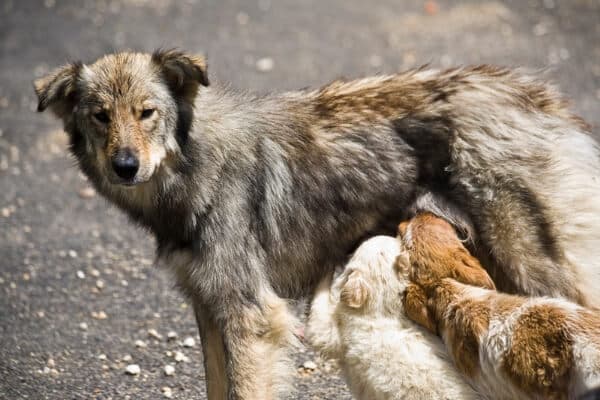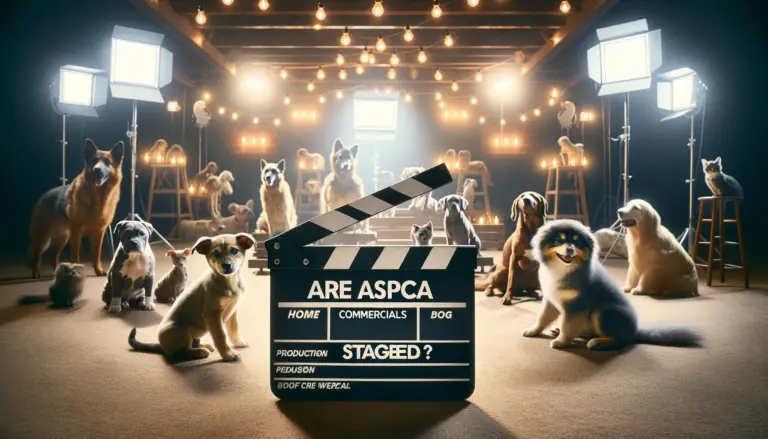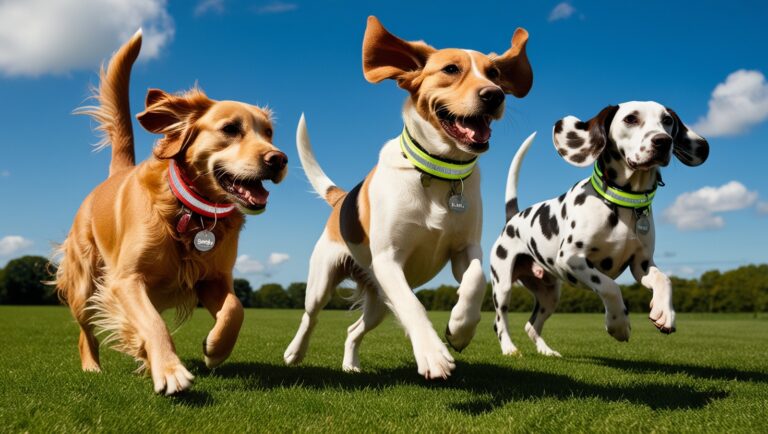Why Are My Dog’s Nipples Sagging? (7 Reasons & Solutions)

Your dog’s nipples sag when ligaments supporting the breast become loose. Female dogs are most likely to experience a sagging nipple as a result of pregnancy and lactation, pseudopregnancy, and old age. Breast infection, mammary gland tumors, and sudden changes in body weight may also cause saggy breasts in dogs.
Like humans, dogs are mammals capable of reproduction. Canines have mammary glands (nipples) and they are vestigial in males.
These small bumps extend from their groin area up to the stomach and the number of nipples can vary depending on the breed, age, and individual characteristics. On average, most pooches tend to have between 6-10 nipples.
Nipples serve the purpose of delivering milk for nursing puppies during lactation but why do dog’s nipples sag? Drawing insights from our extensive experience with breeding services, this post will explain exactly why your dog’s nipples can sag.
Sagging nipples occur most times as a natural phenomenon in dogs and don’t always mean that they need medical attention. However, you should check for other signs like sore or lumpy teats, oozing of pus, and decreased activity levels.
So continue reading to learn about why your dog’s breast is saggy and when it is a major cause for concern.
Why Are My Dog’s Nipples Sagging?
Several reasons are responsible for the sagging nipples observed in dogs. Understanding these causes can help determine if any intervention may be necessary and what possible actions to take in caring for your canine friend.

1. Phantom Pregnancy Or Pseudopregnancy
Bitches sometimes have a weird reproductive cycle. Phantom pregnancy also known as false/pseudopregnancy or pseudocyesis is most common among unspayed female pooches.
This is due to the rapid decrease in the progesterone levels and increase in prolactin during diestrus even when the bitch is not pregnant.
Your bitch will exhibit the same behavioral and physical changes found in pregnant pooches. The physical changes include enlargement and swelling of their teats. This swelling could be discomforting and your dog might constantly lick the nipples, causing irritation which can expose them to infections.
Since false pregnancy is due to hormonal changes, sagging of nipples should resolve at least 3-4 weeks after the heat cycle although it could be longer for some dogs but spaying the bitch will prevent future occurrence.
2. Your Pooch Is Pregnant
Pregnancy brings about various hormonal changes which prepare the female pooches for lactation and feeding of their litter.
Nipple enlargement and swelling begin during the heat cycle up until the weaning of the pups. During pregnancy, the nipples continue to enlarge and become even more prominent after birth as it produces milk for the puppies.
At about 5-6 weeks of the puppies’ age, the pooches’ milk production levels will diminish and the weaning process will begin. The entire weaning period is about one week after which the pooches’ teats will return to normal size and shape.
3. Breast Infection(Mastitis)
Mastitis is a life-threatening bacterial infection of the mammary glands in dogs either male or female, although it usually occurs in bitches who are nursing their litter.
This condition develops as a result of scratches mostly from the nursing pups within and around the pooch’s mammary glands. This exposes the bitch to bacterial infection.
Symptoms include lumpy nipples, discolored or blood-stained milk, teats that are warm and painful to touch, teats are bruised or purplish-blue, avoiding or not wanting to nurse puppies, growling at puppies, restlessness, and dehydration. For nursing pooches, the milk is toxic for affected nipples and is dangerous for the puppies
When dictated on time, it is essential to contact your veterinarian for immediate assessment
4. Genetics
Much like humans, genetics plays a role in the physical changes and appearance of your pooch including changes in the nipples (saggy nipples). Sometimes it could be normal and nothing to worry about.
Due to genetic differences, certain breeds of dogs are more predisposed to developing mammary gland tumors than others. Dogs with increased chances include Boston terriers, Brittany spaniels, cocker spaniels, dachshunds, English setters, and more.
5. Mammary Tumor
Breast cancer in dogs also known as mammary tumors is extremely common often occurring in 25% unspayed female pooches with 50% being malignant. Although rare, mammary tumor develops in male dogs and it tends to metastasize aggressively.
Symptoms include yellowish or bloody discharge or pus from the nipple, painful or swollen breasts, and many bumps and lumps. Systemic symptoms could include lethargy, weight loss, difficulty in breathing, and loss of appetite.
The causes of these tumors are not well understood but it has been linked to genetics and hormonal components as spaying the bitch before their first heat cycle has been shown to drastically reduce or even eliminate the possibility of developing mammary tumors.
Although the role of sterilization or spaying in reducing further cancer is controversial, it may however help to reduce or prevent related illness or infection. The use of mastectomy is usually the best option. It’s therefore imperative to consult your vet anytime you notice any of these symptoms in your four-legged family member.
6. Old Age
With age comes developmental changes as well as declines including sagging nipples in pooches due to loss of skin elasticity and muscle tone
Apart from that, an unspayed/neutered bitch will continue to have heat cycles, and the more heat cycles, the more saggy their nipples will be. So you can spay her as an older dog to reduce the sagging even though there might still be a little bit of sagging due to her age.
7. Extreme Or Abrupt Change In Weight
Significant weight gain or loss can also affect the appearance of the dog’s nipples. Weight gain will lead to stretched and sagging skin leading to loss of elasticity and muscle tone around the nipples while weight loss could leave behind excess skin causing the teats to sag.
What Are The Black Spots Or Gunks On My Dog’s Nipples? (Discolored Dog Nipples)
Why are my dog’s breast sagging but not pregnant?
Many different factors may lead to breast sagging in dogs even without the dogs being pregnant, one of which is false pregnancy. When a bitch goes through this process, she thinks she has puppies. About 60% of every female dog experiences this phenomenon and it’s attributed to hormonal changes whether the dog is bred or not. A common sign is mammary enlargement but also increased appetite and weight gains
Mammary gland infection known as mastitis is another reason for breast sagging. The breast is painful to touch and may have blood-stained secretions. It can be treated with antibiotics.
Breast cancer or mammary tumor also causes breast sagging and usually present as a lump in the mammary gland. There’s a direct correlation between the formation of mammary tumors and the time of spaying. Spaying before the first heat cycle reduces the chance of breast cancer to 0.5%.
Other factors include loss of skin elasticity and muscle tone due to extreme weight gain or loss and old age.
How long does it take for a dog’s nipples to go back to normal after puppies?
Whenever a dam gives birth, the breast enlarges and swells for the sole purpose of milk production for the new litter. During the first several weeks of their lives, puppies rely on their mother’s milk for 100% nutrition.
As the puppies grow and develop, the milk produced by the mother dog won’t be sufficient to feed and sustain them. At about 5-6 weeks of age, the mother’s breast milk supply will start to diminish. The mother dog goes through a weaning process for them.
At this time the pups will have some sharp teeth and claws and be able to eat solid food so should be gradually introduced to solid food with water. The entire weaning process may take one week. However, on average, it takes around 6-10 weeks for her nipples to return to normal after weaning.
When To See The Vet If Your Pooch Has Saggy Breasts
Since sagging breasts may be a normal occurrence in female pooches, certain additional symptoms could be an indication of a more serious underlying issue. Below are pointers that may require you to consult your vet.
1. Teats Are Lumpy or Swollen
The presence of a lump or swelling in and around a female pooch’s breast is an indication of a mammary gland tumor which could be life-threatening.
When noticed it’s important to consult your veterinarian as soon as possible as early detection and intervention are necessary for the quick recovery of your four-legged family friend.
2. Presence Of Redness or Discoloration
When your dog’s breast turns red, it is indicative of an inflammation or infection, and is frequently seen in cases of mastitis, a condition where the mammary glands become infected, often during lactation. The breasts may appear red, swollen, and may be warm to the touch. The dog may also show signs of discomfort or pain.
Discoloration, on the other hand, can sometimes be a sign of more serious issues, such as a tumor or cancer. Canine mammary tumors can lead to changes in the color of the skin or nipple, often turning them darker. In some cases, there can be visible growths, ulcers, or changes in size or shape of the mammary glands
3. If there is a Bloody Or Pus-filled Discharge
A blood or pus-filled discharge is usually the product of infected wounds. This usually occurs when the bitch is pregnant or nursing puppies. The milk produced during this period will be polluted and becomes harmful to the puppies. This can lead to your dog refusing to feed her puppies too
You may also notice your bitch crying, being dehydrated, and lethargic. If left untreated this could become very fatal so make sure to consult your vet to receive treatment as soon as you notice these signs.
4. Teats Are Painful And Warm To Touch
Whenever a touch of your dog’s teats elicits distemper or pain, this could be a sign of inflammation, infection, or other underlying medical issues. These may also prevent your bitches from breastfeeding their fur babies. The infection could travel around the body making her feel ill. Endeavor to consult your veterinarian for assessment and subsequent interventions.
5. Lethargy and Loss of Appetite
Dogs are active mammals with huge appetite but changes in your female dog’s behavior such as loss of appetite and lethargy gives a clue to an underlying medical condition.
It’s essential to observe your bitches overall behavior and seek veterinary services if you notice any concerning changes.
How Do You Reduce Nipple Sagging In Dogs?
Most common causes of sagging nipples are unavoidable such as age, there are however certain measures to help manage these issues.
1. Give Your Pooch The Gift Of Time
Pregnancy and nursing take a significant toll on a dog’s body, including changes such as nipple enlargement and sagging. These changes are a natural part of the reproductive process and don’t revert overnight or even fully.
Providing ample time for your dog to recover is crucial. This period is when her body gradually returns to its former state. Her hormone levels will normalize, and the enlarged mammary glands and vulva will slowly recede.
2. Adequate Exercise
Pregnancy and breastfeeding could take a toll on any bitch. Exercise is one of the efficient ways to tense up a bitch after birth. It helps to strengthen the muscles of the breast and therefore tighten the nipples. It also helps to shed excessive weight.
You can begin by taking your dog for early morning walks at least 48 hrs after delivery. Although many dogs would not like to leave their pups alone. Show her a leash and if she is willing you can proceed and take her out. Maintain shorter periods of exercise at first and let it be done within your immediate environment. After weaning, you can increase the exercise intensity and introduce other play activities like fetch or catch.
3. Proper Diet and Nutrition
Feeding your pooch a balanced diet plays a role in the physique of the bitch and will help your dog’s nipples get back in shape after pregnancy. It is normal for them to eat heavily while breastfeeding. Some may have gained excessive weight while others lost weight after weaning.
Cutting down on calorie intake will be necessary for the overweight bitch while an increase in the frequency of feeding and intake of calorie-rich meals, vegetables, and lean meats will be required for the underweight bitch.
You can also give multivitamin supplements to provide adequate nutrition
4. Healthy Weight Management
Maintenance of a healthy weight is a component of proper diet and regular exercise. Excessive weight gain will lead to sagging breasts due to stretched skin while weight loss can also lead to loose skin which will lead to sag breasts.
You can cooperate with your vet to develop a balanced nutrition and effective exercises regimen befitting for your bitch depending on their age, breed, and activity levels.
5. Consider Collagen Supplements
Collagen is a structural protein found in foods like animal skins and ligaments. It can also come in the form of supplements. It provides structural support to different tissues in the body helping in tissue repairs, and immune responses.
Due to its function, it can help restore the health of your bitch skin and joints by tightening up loose skin around the breast and nipples thereby preventing sagging.
Treating Mother Dog With Breast Infection Or Mammary Tumor
Treatment depends on the underlying cause of sagging breasts. In some cases, treatment may not be required but when there’s an infection, inflammation, or underlying medical issues, consult your vet for appropriate treatment.
Treatment of a mother dog with a breast infection, or mastitis, often includes antibiotics to manage the infection and anti-inflammatory medication to reduce swelling and pain. Frequent nursing or manual milking may be needed to help drain the infected gland. Warm compresses can also ease discomfort and promote drainage. If these measures are ineffective, a vet may need to surgically drain the gland.
On the other hand, mammary tumors require a different approach. If cancer is suspected, diagnostic tests such as biopsies and imaging studies will be carried out. Treatment typically involves surgical removal of the tumor, possibly followed by chemotherapy or radiation, depending on the type and stage of the cancer.
It’s crucial to seek immediate veterinary care if your dog shows signs of either condition, as early intervention can improve prognosis. Always consult a professional for advice tailored to your pet’s specific situation.
How Do You Manage False Pregnancy In Dogs?
Pseudopregnancy is often diagnosed by palpation, ultrasonoscopy, or blood test specifically for the presence of a hormone, known as relaxin. Management of false pregnancy primarily focuses on alleviating symptoms and stabilizing the dog’s hormonal balance.
Mild cases often resolve without intervention within one to three weeks. In these situations, distract your dog with more play or walks. For more severe symptoms, like excessive milk production or severe behavioral changes, veterinary intervention may be necessary. Your vet may administer hormone therapy or prescribe anxiolytic medications to calm your dog.
If a dog experiences recurrent false pregnancies, spaying could be considered to prevent future episodes, as this condition is related to the heat cycle. Do well to monitor the dog closely during this period and ensure that she is comfortable and her health is not adversely affected.
Regular vet checkups are necessary to keep an eye on your pet’s health and to catch any potential issues early.
So, Why Are My Dog’s Nipples Sagging?
Dogs like humans are mammals having mammary glands for milk production. Due to the nature of this delicate tissue, sagging can take a natural course or occurs for several other reasons. The hormonal changes of pregnancy and lactation alone coupled with the age of the pooch cause sagging of the mammary glands.
Other factors contributing to sagging nipples include but are not limited to infections, inflammatory responses, the presence of mammary tumors, hormonal changes in pseudopregnancy, and loss of skin elasticity in overweight or underweight pooches.
Sagging nipples could be a natural process but when there’s an underlying course, the intervention of a vet may be required.
Read related posts about





